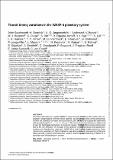Files in this item
Transit timing variations in the WASP-4 planetary system
Item metadata
| dc.contributor.author | Southworth, John | |
| dc.contributor.author | Dominik, M. | |
| dc.contributor.author | Jorgensen, U. G. | |
| dc.contributor.author | Andersen, M. I. | |
| dc.contributor.author | Bozza, V. | |
| dc.contributor.author | Burgdorf, M. J. | |
| dc.contributor.author | D'Ago, G. | |
| dc.contributor.author | Dib, S. | |
| dc.contributor.author | Figuera Jaimes, R. | |
| dc.contributor.author | Fujii, Y. I. | |
| dc.contributor.author | Gill, S. | |
| dc.contributor.author | Haikala, L. K. | |
| dc.contributor.author | Hinse, T. C. | |
| dc.contributor.author | Hundertmark, M. | |
| dc.contributor.author | Khalouei, E. | |
| dc.contributor.author | Korhonen, H. | |
| dc.contributor.author | Longa-Peña, P. | |
| dc.contributor.author | Mancini, L. | |
| dc.contributor.author | Peixinho, N. | |
| dc.contributor.author | Rabus, M. | |
| dc.contributor.author | Rahvar, S. | |
| dc.contributor.author | Sajadian, S. | |
| dc.contributor.author | Skottfelt, J. | |
| dc.contributor.author | Snodgrass, C. | |
| dc.contributor.author | Spyratos, P. | |
| dc.contributor.author | Tregloan-Reed, J. | |
| dc.contributor.author | Unda-Sanzana, E. | |
| dc.contributor.author | von Essen, C. | |
| dc.date.accessioned | 2019-09-24T12:30:02Z | |
| dc.date.available | 2019-09-24T12:30:02Z | |
| dc.date.issued | 2019-12 | |
| dc.identifier | 261010409 | |
| dc.identifier | 510730f9-d626-4b63-a1f4-41aa3ab089be | |
| dc.identifier | 85079679784 | |
| dc.identifier | 000503993100082 | |
| dc.identifier.citation | Southworth , J , Dominik , M , Jorgensen , U G , Andersen , M I , Bozza , V , Burgdorf , M J , D'Ago , G , Dib , S , Figuera Jaimes , R , Fujii , Y I , Gill , S , Haikala , L K , Hinse , T C , Hundertmark , M , Khalouei , E , Korhonen , H , Longa-Peña , P , Mancini , L , Peixinho , N , Rabus , M , Rahvar , S , Sajadian , S , Skottfelt , J , Snodgrass , C , Spyratos , P , Tregloan-Reed , J , Unda-Sanzana , E & von Essen , C 2019 , ' Transit timing variations in the WASP-4 planetary system ' , Monthly Notices of the Royal Astronomical Society , vol. 490 , no. 3 , pp. 4230-4236 . https://doi.org/10.1093/mnras/stz2602 | en |
| dc.identifier.issn | 1365-2966 | |
| dc.identifier.other | BibCode: 2019arXiv190708269S | |
| dc.identifier.other | ORCID: /0000-0002-3202-0343/work/75996710 | |
| dc.identifier.uri | https://hdl.handle.net/10023/18547 | |
| dc.description.abstract | Transits in the planetary system WASP-4 were recently found to occur 80 s earlier than expected in observations from the TESS satellite. We present 22 new times of mid-transit that confirm the existence of transit timing variations, and are well fitted by a quadratic ephemeris with period decay dP/dt = −9.2 ± 1.1 ms yr−1. We rule out instrumental issues, stellar activity and the Applegate mechanism as possible causes. The light-time effect is also not favoured due to the non-detection of changes in the systemic velocity. Orbital decay and apsidal precession are plausible but unproven. WASP-4 b is only the third hot Jupiter known to show transit timing variations to high confidence. We discuss a variety of observations of this and other planetary systems that would be useful in improving our understanding of WASP-4 in particular and orbital decay in general. | |
| dc.format.extent | 480568 | |
| dc.language.iso | eng | |
| dc.relation.ispartof | Monthly Notices of the Royal Astronomical Society | en |
| dc.subject | Planetary systems | en |
| dc.subject | Stars: fundemental parameters | en |
| dc.subject | Stars:activity | en |
| dc.subject | Stars: individual: WASP-4 | en |
| dc.subject | QB Astronomy | en |
| dc.subject | QC Physics | en |
| dc.subject | 3rd-DAS | en |
| dc.subject.lcc | QB | en |
| dc.subject.lcc | QC | en |
| dc.title | Transit timing variations in the WASP-4 planetary system | en |
| dc.type | Journal article | en |
| dc.contributor.institution | University of St Andrews. School of Physics and Astronomy | en |
| dc.contributor.institution | University of St Andrews. St Andrews Centre for Exoplanet Science | en |
| dc.identifier.doi | https://doi.org/10.1093/mnras/stz2602 | |
| dc.description.status | Peer reviewed | en |
| dc.identifier.url | http://adsabs.harvard.edu/abs/2019arXiv190708269S | en |
This item appears in the following Collection(s)
Items in the St Andrews Research Repository are protected by copyright, with all rights reserved, unless otherwise indicated.

